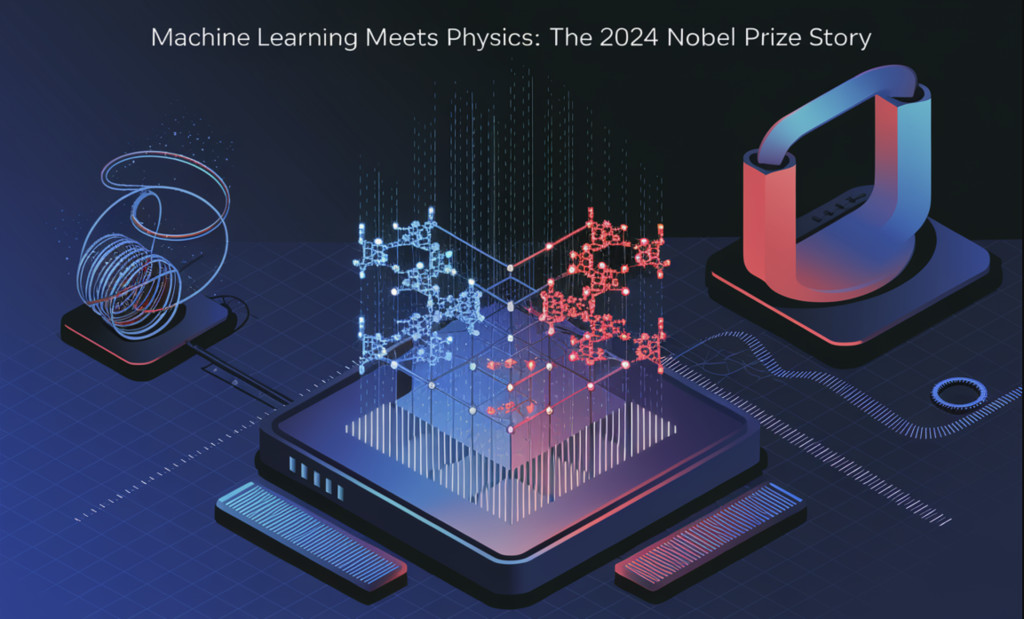The 2024 Nobel Prize in Physics has been awarded to two pioneering figures in the field of artificial intelligence: John J. Hopfield of Princeton University and Geoffrey E. Hinton of the University of Toronto. They were recognized for their groundbreaking work in developing foundational machine learning technologies using artificial neural networks—work that has had a transformative impact on both the fields of physics and artificial intelligence.
John Hopfield’s Contribution
John Hopfield’s early contributions focused on creating an artificial neural network that could function as an associative memory, storing and reconstructing patterns. His model, known as the Hopfield network, was inspired by the physics of atomic spins and uses an energy-based system to find the closest match for incomplete or noisy input data. This concept of energy minimization allowed neural networks to learn and recognize patterns, providing a crucial framework for many subsequent AI technologies.
Geoffrey Hinton’s Contribution
Geoffrey Hinton, meanwhile, extended Hopfield’s concepts and applied them to the development of what is known as the Boltzmann machine. Using ideas drawn from statistical physics, Hinton’s network was able to learn the underlying structure of data autonomously, enabling machine learning to perform tasks like identifying features within an image. This innovation helped kickstart the broader application of deep learning, leading to the rapid development of machine learning that we see today. Hinton’s work in the 1980s laid the groundwork for modern neural networks, directly influencing the powerful AI systems that are currently employed across industries from healthcare to technology.
Cross-Disciplinary Significance
The awarding of the Nobel Prize to these two scientists is significant not only because of their foundational research but also due to the cross-disciplinary nature of their contributions. Their use of principles from physics to solve problems in computation exemplifies how breakthroughs can emerge from the intersections of different fields. In particular, the techniques they developed have enabled artificial neural networks to learn in ways that parallel the human brain, giving machines the capacity for a kind of rudimentary perception—a major leap forward for artificial intelligence.
Artificial Neural Networks: Bridging Physics and AI
Artificial neural networks, the technology underlying these researchers’ achievements, function by creating models inspired by the structure and function of the human brain. Nodes in these networks represent neurons, which interact through connections analogous to synapses. These nodes are adjusted during training to strengthen certain connections, mimicking the learning process of biological brains. The Hopfield and Boltzmann models were early successes in using physics to make these neural networks capable of memory retention and learning, bridging a gap between artificial intelligence and human-like capabilities.
AI as a Natural Extension of Physical Sciences
One of the most remarkable aspects of this year’s Nobel Prize in Physics is its emphasis on artificial intelligence as a natural extension of physical sciences. Physics, traditionally concerned with the natural laws governing the universe, now finds itself playing a critical role in the ongoing revolution in artificial intelligence. This kind of interdisciplinary breakthrough underscores the importance of thinking beyond disciplinary boundaries to solve complex global challenges. As noted by Ellen Moons, Chair of the Nobel Committee for Physics, the laureates’ work has had wide-ranging implications, including applications in material science where neural networks are used to design materials with desired properties.
Impact on Modern Machine Learning Models
The Hopfield and Boltzmann networks are more than relics of early AI—they have been foundational to the structure of many modern machine learning models, especially those used for pattern recognition and deep learning applications. Today’s neural networks, such as convolutional neural networks (CNNs) and transformer-based models, owe much of their architecture to the foundational ideas introduced by Hopfield and Hinton. These developments have made it possible for machines to achieve unprecedented accuracy in tasks ranging from medical imaging diagnostics to language translation.
Recognition of AI’s Scientific Value
The decision by the Royal Swedish Academy of Sciences to award the Nobel Prize in Physics to these two pioneers acknowledges the profound impact that their contributions have had on science and society. It also serves as recognition of artificial intelligence as a legitimate domain within the realm of the natural sciences. This year’s Nobel Prize underscores the role of machine learning as not just a set of engineering tools but as a transformative scientific paradigm.
The Enduring Importance of Curiosity-Driven Research
In recognizing Hopfield and Hinton, the Nobel Committee has highlighted the enduring importance of curiosity-driven research. Their foundational discoveries in the 1980s have blossomed into technologies that are today considered indispensable across numerous fields. The impact of their work extends well beyond theoretical interest; it has paved the way for practical applications that touch many aspects of modern life—from personalized recommendations on streaming platforms to advancements in scientific research, such as drug discovery and climate modeling.
Conclusion
The awarding of the Nobel Prize in Physics to pioneers of machine learning reflects a broader trend of integrating computational models into the core of scientific inquiry. The contributions of John Hopfield and Geoffrey Hinton remind us that innovations often emerge from exploring unexpected connections between disciplines, providing a powerful example of how foundational scientific research can have far-reaching implications for technology and human progress.
Check out the Details here. All credit for this research goes to the researchers of this project. Also, don’t forget to follow us on Twitter and join our Telegram Channel and LinkedIn Group. If you like our work, you will love our newsletter.. Don’t Forget to join our 50k+ ML SubReddit
[Upcoming Event- Oct 17 202] RetrieveX – The GenAI Data Retrieval Conference (Promoted)
The post Machine Learning Meets Physics: The 2024 Nobel Prize Story appeared first on MarkTechPost.
Source: Read MoreÂ

![Why developers needn’t fear CSS – with the King of CSS himself Kevin Powell [Podcast #154]](https://devstacktips.com/wp-content/uploads/2024/12/15498ad9-15f9-4dc3-98cc-8d7f07cec348-fXprvk-450x253.png)